
The University of California at Berkeley erupted in 1964 into protests over freedom of speech and set the stage for campus unrest in the turbulent 1960s. We hear an excerpt of one the Free Speech Movement’s leading voices, the late Mario Savio speaking in 1964, and talk to his widow Lynne Hollander as well as Michael Rossman. [Includes transcript]
- Mario Savio, recorded on December 3, 1964 at the University of California Berkeley shortly before Free Speech Movement demonstrators entered Sproul Hall to begin their sit-in.
- Lynne Hollander, Mario Savio’s widow speaking from Pacifica Radio’s KPFA studio with Amy Goodman.
- Michael Rossman, one of the members of the Free Speech Movement (FSM) speaking from Pacifica Radio’s KPFA studio with Amy Goodman.
Transcript
JUAN GONZALEZ: Joan Baez singing, “We Shall Overcome”. You’re listening to Democracy Now!. I’m Juan Gonzalez. Amy Goodman joins us from Pacifica radio at KPFA studios. Amy, you are in Berkeley for the seventh annual Mario Savio memorial lecture.
AMY GOODMAN: Right. That was last night. In the process doing a lot of research into just what the free speech movement was all about. Certainly, something that many people don’t have to research because they were there. But there’s a whole new generation of people who were not. Last night, it was very interesting to meet a number of people who were deeply involved in that movement. I’m looking now at a new book that’s out, Juan, called “The Free Speech Movement, Reflections on Berkeley in the 1960’s”. And it talks about Mario Savio and the Free Speech Movement.
It begins by saying — beginning in 1969, the Berkeley campus of the University of California chose to revamp the traditional graduation exercises. The reason for the change attested to the continuing impact of student activism unleashed by the Free Speech Movement of 1964, known as FSM, the director of public ceremonies, the faculty member summed up the problem in a memo to the chancellor. He said before this year, the campus accepted our choice of representative student speakers. From now on, we’re in trouble.
The message could not have been clearer. Its implications went far beyond the choice of graduation speakers.
In the 1960’s, first on the Berkeley campus and nationally and internationally, students tested the limits of permissible dissent, challenged the conventional wisdom in unprecedented ways and insisted on participating as active agents in the shaping of history. That’s the achievement of the Free Speech Movement and each new class of Berkeley inherits that legacy.
There’s an introduction by Robert Cohen, one of the editors of this book. He talks about the man who played the leading role in the Free Speech Movement. He was the Berkeley student rebellion’s most eloquent orator, the one who first spoke from atop the police car that his fellow protesters surrounded and mobilized on October 1, 1964, to prevent the arrest of Jack Weinberg — a civil rights activist whose only crime had been to defy the administration’s prohibition against political advocacy on university property.
He was Mario Savio, and the mass protest around the police car on Sproul Plaza, the central campus thoroughfare, helped to launch the Free Speech Movement.
Mario’s “Operation of the Machine” Speech, which was given just before the December Sproul Hall sit-in, not only set the tone for the non-violent occupation of the administration building, which culminated in the largest mass arrest of students in American history, but also became the most famous oration in the early history of the New Left. I want to just go to an excerpt of that speech right now. This is Mario Savio.
MARIO SAVIO: We were told the following — if President Kerr actually tried to get something more liberal out of the Regents in his telephone conversations, why didn’t he make public statements to that effect? The answer we received, from a well meaning liberal, was the following — he said, would you ever imagine the manager of a firm making a statement publicly in opposition to its board of directors? That’s the answer?
I ask you to consider — if this is a firm, and if the Board of Regents are the board of directors and if President Kerr is in fact the manager, then I tell you something, the faculty are a bunch of employees and we are the raw materials — but we’re a bunch of raw materials that don’t mean to have any process upon us, don’t mean to be made into any product, don’t mean to end up being bought by some clients of the university, be they of government, be they industry, be they organized labor, be they anyone. We’re human beings.
There is a time when the operation of the machine becomes so odious — makes you so sick at heart that you cannot take part. You cannot even passively take part. And you’ve got to put your bodies on the gears and upon the wheels and levers, upon all of the apparatus and you have to make it stop and you have got to indicate to the people who run and own it, that unless you are free, the machine will be prevented from working at all.
JUAN GONZALEZ: That was Mario Savio speaking in 1964. Amy?
AMY GOODMAN: That’s right. And last night, I went over to the steps where Mario Savio gave that address, that now has a small plaque. It was a battle to get that, but a small plaque that — well, it doesn’t refer to the Free Speech Movement, but it does say “Mario Savio’s Steps”. It was dedicated in 1997. He died in 1996. Juan, we’re joined today by the widow of Mario Savio, who was a key member of the free speech movement herself. Lynn Holloway Savio. [Lynn whispers a correction]
AMY GOODMAN: Lynn Hollander Savio. And we’re also joined by Michael Rossman, who is trying to maintain the Free Speech Movement archive and was an active member himself, walked in that day, as Lynn did, and so many thousands of others, to Sproul Hall. Can you talk about that day, Lynn?
LYNN HOLLANDER: Yeah, sure. When I hear those words it, still makes me cry. You know, it was a tremendous moment for all of us. I mean, because we felt so determined to right what seemed to us just an incredible injustice that was going on — on the Berkeley campus, and so full of a sense that we, working together, could accomplish something that would affect, you know, our lives, and other people’s lives.
AMY GOODMAN: To back up for a minute, going back to why this Free Speech Movement developed in Berkeley, we’re talking about the summer of 1964. Michael Rossman, maybe you can talk about the significance of that summer in this country.
MICHAEL ROSSMAN: Well, you actually have to back up, because this developed at Berkeley because this locale has been intensely progressive since the 1930’s. This was the place where the revolt against the House Un-American Activities Committee happened in 1960. It was substantially organized by Berkeley students, and a lot got arrested in the protest against that. That is what broke the back of the principle force of repression against free speech in the country.
From that point on, a student movement started to spread relatively unfettered, that concerned itself mostly with issues of peace and civil rights for the first years up to 1964. There had been great civil rights activity in the whole Bay area, student-led — successfully from 1962, 1963, 1964. 500 students were involved in precinct work. The Republican Convention was coming to town, and a bunch of radical Republican students wanted to go picket against Scranton, the anointed choice, and so on. We came to school — back to school — -
AMY GOODMAN: This was the Goldwater Republican Convention.
MICHAEL ROSSMAN: This was it.
AMY GOODMAN: Barry Goldwater.
MICHAEL ROSSMAN: We came back to school that fall and we, including a number of activists — not only Mario, but a bunch of others — who had been down in Mississippi summer working to register voters in the south, when potential voters and activists were getting killed. With a lot of passion, we came back to school and the university administration said, well, sorry, you cannot give out pamphlets. You cannot recruit members. You cannot raise money for student political organizations on campus anymore. Over the previous seven years when the New Left had been rising, we had gotten shoved to the very edge of campus in a little 20-foot brick strip, where we put up our pitiful card tables to conduct these activities, and they said “go”.
So, we later — we soon actually had reason to think that this was due to the administration being called by Bill Noland, the publisher of this — at that time, reactionary Oakland paper.
In any case, we began to organize the dissent. We negotiated for two weeks fruitlessly and finally took our tables for various causes, in particular civil rights causes, to the card tables and set them up not on the edge of campus, but right in front of the administration building and started handing out literature and collecting donations. Lo and behold, they brought a police car on campus.
That came to be commonplace, but no one had ever seen police on the university campus come to arrest students in political activity ever in this country. They came and arrested a core organizer, Jack Landburg, put him in the car, started to take him away and we sat down around the car.
AMY GOODMAN: This was the key moment.
MICHAEL ROSSMAN: This was the explosive moment.
AMY GOODMAN: Sitting down around the car on October 1, 1964.
MICHAEL ROSSMAN: 3,000 students sat around the car and kept it from taking Jack off to prison for about a day and a half. And we had a dialogue. Mario stepped on top of the car as the first person to speak, and there was an open microphone there for 30 hours. It was literally —
AMY GOODMAN: Also key organizers were there for the Free Speech Movement.
MICHAEL ROSSMAN: A whole parade of mundane heroes and heroines. I had never heard a public dialogue in America until that time. I was a graduate student. They brought in 600 cops. They were about to arrest us and beat us into the ground — was the orders given them. At very last moment, our negotiating committee announced a deal had been reached with the president of the university to call off the cops, release the imprisoned core worker, and negotiate the issues of political activity.
A committee was formed by the administration staffed with administration representatives, and it went on from there both downhill and uphill until we had gotten the entire campus involved in dissent and protest.
AMY GOODMAN: November 20 —
JUAN GONZALEZ: When you say —
AMY GOODMAN: November 20th is actually the anniversary.
AMY GOODMAN: Go ahead, Juan.
JUAN GONZALEZ: When you say that you are getting the entire campus involved — what forms did that take?
MICHAEL ROSSMAN: It took every form it could. We petitioned — mainly, we talked. We talked to each other. We talked in the dormitories. We talked in the departmental convocations. We talked in the public square in Sproul Plaza for rallies and meetings every day, While the faculty and the administration detoured.
AMY GOODMAN: And, Lynn, the professors got involved as well.
LYNN HOLLANDER: Yes. There was a very strong movement. There were both conservative professors working on the behalf of the administration, and there was a large group of what we called the “Young Turks” on the faculty who — some of whom were quite brave because they didn’t even have tenure yet — who worked tirelessly to organize faculty to support the students.
AMY GOODMAN: You had a group called the “Committee of 200”, of professors?
LYNN HOLLANDER: Yes.
AMY GOODMAN: Who were taking on the administration as well — so they were being hit from all sides. So, you had November 20th, which was actually the anniversary yesterday, that was one of the major marches of students on campus. Then you move into those days of December that led to — well, we just heard, Mario Savio giving that address, and the sit-in at Sproul Hall, the largest student — largest number of students ever arrested in U.S. history.
LYNN HOLLANDER: I think it was — At the time it was the largest number of anybody ever arrested in U.S. history.
MICHAEL ROSSMAN: It’s important to understand that it was important not because of the largeness of it, but because it was the very first time that students had been arrested in protest on a university campus. The strike afterwards, half the campus turned out and paralyzed the campus for several days until the academic senate finally came and voted in our favor that free exercise of speech should not be restricted.
This was the first time that students had gone to the wall anywhere in the country to defend free speech and it opened the doors afterwards immediately the following spring, we began to organize the first mass anti-war movement in the country. The movement against the Vietnam war didn’t technically begin with this, but it did on a mass basis, and —
AMY GOODMAN: Lynn, your thoughts when you walked into Sproul Hall to occupy and take over. At points there were hundreds of police, is that right?
LYNN HOLLANDER: Yes.
AMY GOODMAN: Thousands of police. You knew this was changing everything.
LYNN HOLLANDER: Yes. And you know, we were scared because, you know, the police image we had — was of very big, very brutal people. Most of us had never really had a confrontation with a policeman in our life. We were largely white middle class students. But we felt that, you know, working together, we were a strong force, and just the power of that moment is really unforgettable, Amy.
JUAN GONZALEZ: And Lynn Hollander, can you tell as you little bit about Mario Savio himself? What led him to take these actions and to provide the leadership that he did in those days?
LYNN HOLLANDER: Well, you know, Mario grew up a very serious Catholic student, and the tradition of the Catholic social justice movement was extremely important to him, and from — in his high school days, he became involved with — I believe, the Newman Club, and went to Mexico to do some improvements in the villages there. And so, he came — when he came to Berkeley, he already had this dedication to — and compassion for people that he felt a moral obligation to act upon, and when he went to the south, he went to Mississippi in the summer of 1964.
That summer was the summer that three civil rights workers were murdered in Mississippi. Andrew Goodman, Mickey Schwerner and James Cheney.
For people who read about that, let alone the people who had been in Mississippi and experienced the terror that black people in Mississippi lived with every day of their lives, to come back to the university and then find they were being prevented from doing anything on campus about that situation was just untenable.
AMY GOODMAN: I just want to say, Juan, before we wrap up, as we look at the Free Speech Movement of 1964 and Mario Savio right through to today, last night, I met some young people who are facing administration sanctions for being part of the major protests of more than 1,000 people on Berkeley campus, the day after the invasion began, that was March 20 of this year, Michael Smith, Rachel Otis and Snihal Shingavi. While the charges were dropped against more than 100 students, they have been sentenced to community service, and there is a big movement on campus to challenge that administration sanction, harkening back to 1964. And they were there last night talking about Mario Savio and the movement that began here in Berkeley in that summer of 1964.
JUAN GONZALEZ: And that’s going to have to do it for today’s show. I want to thank Lynn Hollander Savio, the widow of Mario Savio, Michael Rossman, one of the members of the Free Speech Movement. Both were involved with him in the 1964 Free Speech Movement.
That does it for today’s show. For a copy of the program call 1-800-881-2359. Our website is democracynow.org.

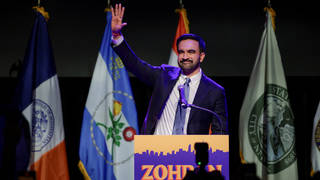
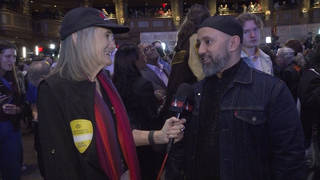
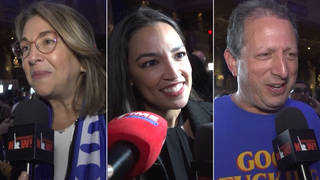
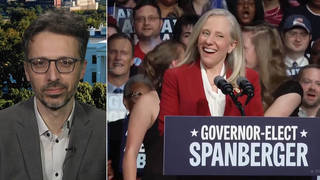





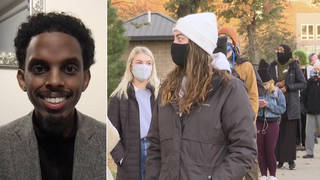

Media Options